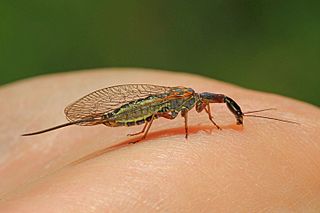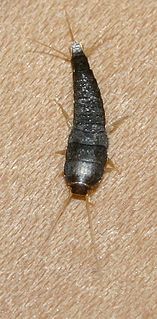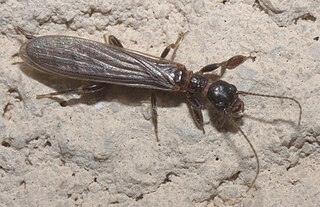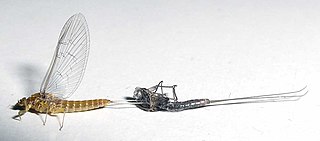 W
WAcanthacorydalis is a genus of insects belonging to the family Corydalidae.
 W
WAgulla is a genus of modern snakeflies in the family Raphidiidae.
 W
WAmeletus is a genus of mayfly and the type genus of the family Ameletidae.
 W
WAposthonia is a genus of webspinners of the family Oligotomidae. The genus was described by Krauss in 1911.
 W
WApterygon is a genus of louse. It is endemic to New Zealand and is an ectoparasite of kiwi birds (Apteryx). Theresa Clay circumscribed the genus in 1961. In 1947, she had referred to this genus as "New Genus D", but it was not formally named as she needed to confirm the host of her specimen as well as additional material.
 W
WCerynia is a genus of flatid planthoppers found mainly in the forested regions of tropical Southeast Asia.
 W
WCorydalus is a genus of large flying insects in the Corydalidae family, commonly known as dobsonflies. They are endemic to North, Central and South America and there are about 35 known species. Members of the genus have wing lengths of up to 85 millimetres. They are sexually dimorphic, with the males having large mandibles used to grasp the females during mating while the females have smaller jaws. The larvae are known as hellgrammites and are aquatic predators.
 W
WDilta is a genus of primitive insects belonging to the family Machilidae. These insects are slender and wingless with dull, often mottled, colouring. They are typically found on the ground in heavily vegetated places. Dilta spp are restricted to western Europe and parts of north Africa.
 W
WElenchus is an insect genus in the family Elenchidae.
 W
WThe genus Haematomyzus includes three species of lice that differ so markedly from all other lice that they have been placed in a suborder of their own. These unusual lice are ectoparasites of elephants and warthogs. Their mouthparts are elongated to form a drill-like structure that allows them to penetrate the thick skin of their host.
 W
WHarpobittacus is a genus of hangingfly or scorpionfly of the family Bittacidae found in Australia.
 W
WLepisma is a genus of primitive insects in the order Zygentoma and the family Lepismatidae.
 W
WMachilis is a genus of jumping bristletails in the family Machilidae.
 W
WMachiloides is a genus of rock bristletails in the family Meinertellidae. There are at least two described species in Machiloides.
 W
WMenacanthus is a genus of chewing lice which parasitise birds. The taxonomy of this genus is highly uncertain. Most taxonomies have given this genus as having over a hundred species, but recent studies have synonymised dozens of species and found other names to be invalid. Some Menacanthus species remain to be discovered, or are synonymised in error. Menacanthus lice feed on the blood of a wide variety of birds, including chickens, by piercing the quills of feathers and gnawing the epidermis. In doing so, they can spread disease and lower egg production. In Menacanthus stramineus, eggs are incubated for four or five days, each of the three nymphal stages lasts for about three days, and adult life for about twelve days. Females produce as many as four eggs in a day, averaging 1.6 eggs a day, with egg production peaking 5–6 days after reaching adulthood. On sparrows, Menacanthus lice are particularly common, and are found in many different niches, consuming blood and feathers.
 W
WMeromenopon is a genus of chewing lice which parasitise birds. The species Meromenopon meropsis is a parasite of bee-eaters.
 W
WNeoneuromus is a genus of dobsonfly endemic to the Indomalayan realm with 13 species. The larvae breed in montane streams. Adults are large with a forewing of 43 to 68 mm length and the body is yellow to red or brown with black marks on the head and pronotum. The wings are marked in dark patterning in the membrane and along the veins. They are closely related to Nevromus from which they are separated by the attenuation of the 9th sternum with an incised tip.
 W
WNisia is a genus of planthoppers in the family Meenoplidae. Species in the genus are known from Africa, Asia and Australia. Most species are associated with monocotyledonous host plants, particularly sedges in the family Cyperaceae.
 W
WOligotoma is a genus of webspinners, insects in the order Embiidina, also known as Embioptera. The type species is Oligotoma saundersii and the type locality the Indian subcontinent. The males have wings but the females are flightless. Embiids are recognisable by the enlarged front tarsi, which contain a large number of silk glands that they use to spin the threads they use for building the tubes and galleries in which they live.
 W
WPetridiobius is a genus of jumping bristletails in the family Machilidae. There are at least two described species in Petridiobius.
 W
WProcloeon is a genus of small minnow mayflies in the family Baetidae. There are at least 20 described species in Procloeon.
 W
WRallicola is a genus of chewing louse. It is an ectoparasite of rails and other birds. It was named by Thomas Harvey Johnston and Launcelot Harrison in 1911. There are two subgenera aside from the nominotypical subgenus: Aptericola, whose species are found on kiwi birds, and Huiacola, a monospecific subgenus consisting of Rallicola extinctus, once found on the huia.
 W
WStylops is a genus of obligately endoparasitic insects in the family Stylopidae. Hosts are typically members of the order Hymenoptera. The official seal, and later logo, of the Royal Entomological Society features a male Stylops.
 W
WSyntermes is a genus of large surface foraging termites belonging to the family Termitidae. The genus is most recognized for the large mounds built from loose soil, with some as old as 4,000 years.
 W
WThermobia is a genus of primitive insects belonging to the family Lepismatidae. The genus was erected by Ernst Evald Bergroth in 1890. By far the best known member of the genus is the firebrat T. domestica, which is often seen in warm places indoors such as bakeries.
 W
WXenos is a genus of insects belonging to the family Stylopidae. The word derives from the Greek word for strange. A species of the genus is Xenos vesparum, first described by Pietro Rossi in 1793. The females are permanent entomophagous endoparasites of Polistes paper wasps. They dwell their whole lives in the abdomens of wasps.
 W
WZorotypus is a genus of angel insects in the familyZorotypidae. The type species is Zorotypus guineensis.